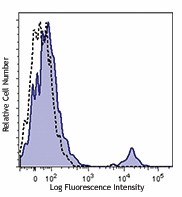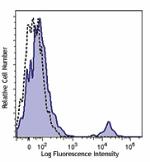- Clone
- OX-26 (See other available formats)
- Regulatory Status
- RUO
- Other Names
- Transferrin Receptor, T9
- Isotype
- Mouse IgG2a, κ
- Ave. Rating
- Submit a Review
- Product Citations
- publications

-

LOU rat bone marrow was stained with CD71 (clone OX-26) APC (filled histogram) or mouse IgG2a, κ APC (open histogram) isotype control.
| Cat # | Size | Price | Quantity Check Availability | Save | ||
|---|---|---|---|---|---|---|
| 204411 | 25 µg | 63€ | ||||
| 204412 | 100 µg | 157€ | ||||
CD71 is a 95 kD type II transmembrane protein. It is expressed on proliferating cells, reticulocytes, and brain endothelium. It is involved in the activation, proliferation, and iron metabolism of cells.
Product DetailsProduct Details
- Verified Reactivity
- Rat
- Antibody Type
- Monoclonal
- Host Species
- Mouse
- Immunogen
- PHA-activated rat lymph node cells
- Formulation
- Phosphate-buffered solution, pH 7.2, containing 0.09% sodium azide.
- Preparation
- The antibody was purified by affinity chromatography and conjugated with APC under optimal conditions.
- Concentration
- 0.2 mg/ml
- Storage & Handling
- The antibody solution should be stored undiluted between 2°C and 8°C, and protected from prolonged exposure to light. Do not freeze.
- Application
-
FC - Quality tested
- Recommended Usage
-
Each lot of this antibody is quality control tested by immunofluorescent staining with flow cytometric analysis. For flow cytometric staining, the suggested use of this reagent is ≤0.5 µg per million cells in 100 µl volume. It is recommended that the reagent be titrated for optimal performance for each application.
- Excitation Laser
-
Red Laser (633 nm)
-
Application References
(PubMed link indicates BioLegend citation) -
- Jefferies WA, et al. 1985. Immunology 54:333.
- RRID
-
AB_2565646 (BioLegend Cat. No. 204411)
AB_2565647 (BioLegend Cat. No. 204412)
Antigen Details
- Structure
- 95 kD type II homodimer
- Distribution
- Expressed on all proliferating cells, reticulocytes and erythrocyte precursors.
- Function
- Involved in activation, proliferation, and iron metabolism of cells.
- Ligand/Receptor
- Transferrin
- Biology Area
- Immunology
- Molecular Family
- CD Molecules
- Antigen References
-
1. Jefferies WA, et al. 1985. Immunology 54:333.
- Gene ID
- 7037 View all products for this Gene ID
- UniProt
- View information about CD71 on UniProt.org
Related FAQs
Other Formats
View All CD71 Reagents Request Custom Conjugation| Description | Clone | Applications |
|---|---|---|
| Purified anti-rat CD71 (transferrin receptor) | OX-26 | FC |
| FITC anti-rat CD71 (transferrin receptor) | OX-26 | FC |
| PE anti-rat CD71 (transferrin receptor) | OX-26 | FC |
| APC anti-rat CD71 (transferrin receptor) | OX-26 | FC |
Compare Data Across All Formats
This data display is provided for general comparisons between formats.
Your actual data may vary due to variations in samples, target cells, instruments and their settings, staining conditions, and other factors.
If you need assistance with selecting the best format contact our expert technical support team.
-
Purified anti-rat CD71 (transferrin receptor)

LOU rat splenocytes stained with OX-26 purified, followed by... -
FITC anti-rat CD71 (transferrin receptor)

LOU rat bone marrow cells stained with OX-26 FITC -
PE anti-rat CD71 (transferrin receptor)

LOU rat bone marrow was stained with CD71 (clone OX-26) PE (... -
APC anti-rat CD71 (transferrin receptor)

LOU rat bone marrow was stained with CD71 (clone OX-26) APC ...
 Login / Register
Login / Register 













Follow Us